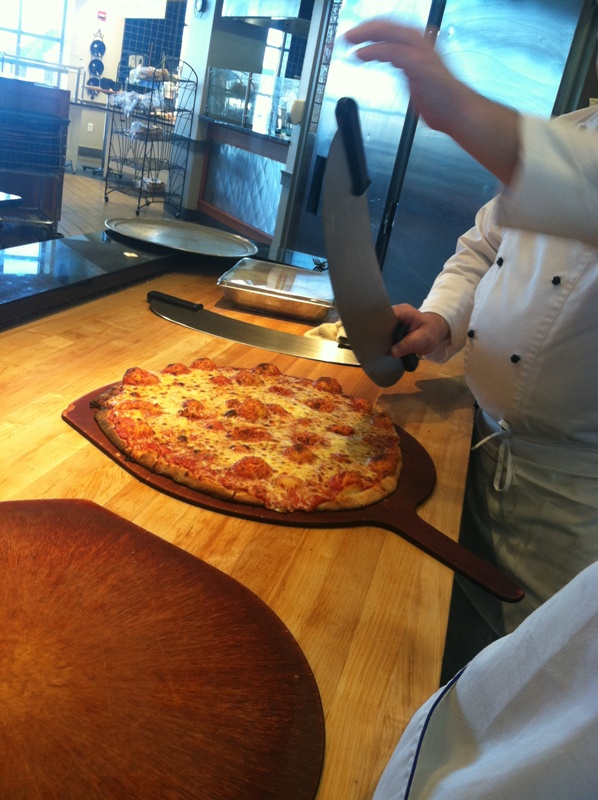Last month I paid my second visit to the University of New Hampshire as a consultant to their dining services program. UNH partnered with Guiding Stars in the fall of 2009 as part of a comprehensive plan to support a healthier student and staff population. A key goal was to improve the nutrition of the menu and retail items served on campus. However, many of UNH’s original recipes did not earn any Guiding Stars for nutrition, and despite their best efforts to modify their formulas, the chefs just couldn’t figure out why.
Dining services director John Plodzik wisely chose to arm the chefs with better knowledge about how to improve the nutrition of recipes without compromising taste. I was hired to bridge the gap between these classically trained chefs and the scientific algorithm they now had to factor into recipe management. Balancing flavor and health is a challenge for home and commercial cooks alike, but the difficulties compound with the sheer volume of servings that a facility like UNH produces on a daily basis. An error in just one preparation of 3,000 servings of just one menu item can cost the program not only a ton of money, but also wastes a lot of food and the time of talented staff. The stakes are high with volume this enormous.
Preparing 3.8 million meals annually (almost 17,000 per day) is an epic endeavor, and UNH’s numerous kitchens reflect the scale of the effort. Stand mixers are as large as bathtubs and bread ovens look like cozy spaces for cocktail parties. On the day I was visiting, an incomprehensible amount of high-quality sushi was being prepared for dinner at Holloway Commons, home of the campus’s largest dining hall. Considering the scale and tight scheduling of this operation, complicating this kitchen’s production with unfamiliar techniques or equipment requirements–or even unusual or expensive ingredients–wasn’t an option.
My solution was to convert my own recipes into high-volume formulas that would work within UNH’s production models. We reduced fat, sugars and sodium from existing recipes so that they would earn Guiding Stars. This process required that we be mindful of the existing equipment limitations, the available labor and varied skill sets and each area’s serving schedule. My personal aim was to walk away at the end of the day knowing that these chefs had the knowledge to achieve this goal themselves.
After my recent visits, the UNH chefs’ ability to develop and adjust nutritious recipes did indeed skyrocket. One chef remarked that the Guiding Stars rating system actually motivated him to work harder to find the perfect balance between taste and nutrition; in fact, he took it as a personal challenge, a game of sorts, to make the best-tasting product with the highest nutrition. We worked together to develop several high-priority items that had vexed the team for months: a healthy pizza and a unique, high-protein menu item that would appeal to vegetarians.

The chefs and I worked together to scale up my Secret Weapon Bread Dough. A recipe I developed for picky kids almost two years ago, it’s a white whole wheat bread dough fortified with dietary fiber and boasting around 8g of protein per serving. I knew that this product would enhance UNH’s repertoire simply because of its inherent nutrition and versatility. Used as a pizza crust, a cinnamon bun, a bread stick or even just enjoyed alongside a light salad, bread made from Secret Weapon Bread Dough stands in at any meal as the protein source rather than a starchy carb side. As such, it opens up a whole new world of possibilities for meatless-but-protein-rich menu items that are cost-effective, easy to produce and appealing to the pickiest students.
Even when scaled to an enormous quantity, the dough performed like magic, rising well, performing flawlessly when formed by hand or in the dough forming equipment UNH employs and best of all, it baked up evenly and quickly in the dining hall’s brick pizza oven. With a high fiber and high protein base, the healthy pizza world seemed to open up before our eyes. Whether as traditional red-sauced pizza, garlicky breadstick dippers or even as a dessert pizza (spread with a spiced raisin paste and topped with fresh apple slices and granola), every item came out perfectly. Best of all, the response we received from the students who tried our creations was unequivocally positive.
Last month, UNH Dining Services was awarded the prestigious Goldie Award from FoodService Director Magazine, which recognizes exemplary efforts to keep members of the campus community healthy. In its Goldie Award profile video, UNH credited its partnership with Guiding Stars, as well as the work I’m doing with the culinary team, as an important factor in achieving their healthy campus goals.
As students transition into adulthood, the evolution of their food preferences begins to solidify, but we still have some time yet to influence the permanent habits and food knowledge that they adopt. UNH dining services staff is producing a finished product that will ensure their students get the best chance to develop an appreciation for the flavor of well-prepared, healthy foods. I’m glad to have a role in this important work, and after spending more and more time on campus with students and staff, it’s clear to me that some of Guiding Stars’ most meaningful influence seems to extend beyond the supermarkets it’s most often associated with and into arenas where students are learning to make nutritious choices that will help them achieve their best in life.